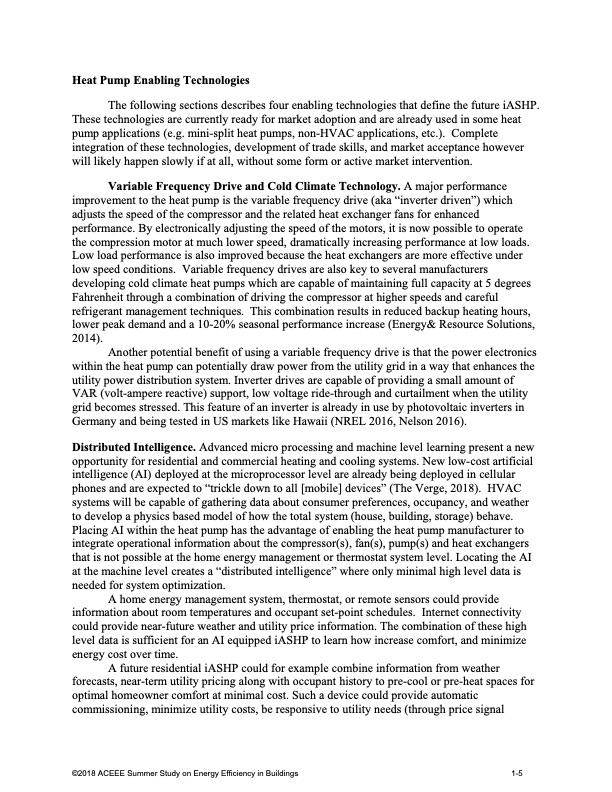
PDF Publication Title:
Text from PDF Page: 005
Heat Pump Enabling Technologies The following sections describes four enabling technologies that define the future iASHP. These technologies are currently ready for market adoption and are already used in some heat pump applications (e.g. mini-split heat pumps, non-HVAC applications, etc.). Complete integration of these technologies, development of trade skills, and market acceptance however will likely happen slowly if at all, without some form or active market intervention. Variable Frequency Drive and Cold Climate Technology. A major performance improvement to the heat pump is the variable frequency drive (aka “inverter driven”) which adjusts the speed of the compressor and the related heat exchanger fans for enhanced performance. By electronically adjusting the speed of the motors, it is now possible to operate the compression motor at much lower speed, dramatically increasing performance at low loads. Low load performance is also improved because the heat exchangers are more effective under low speed conditions. Variable frequency drives are also key to several manufacturers developing cold climate heat pumps which are capable of maintaining full capacity at 5 degrees Fahrenheit through a combination of driving the compressor at higher speeds and careful refrigerant management techniques. This combination results in reduced backup heating hours, lower peak demand and a 10-20% seasonal performance increase (Energy& Resource Solutions, 2014). Another potential benefit of using a variable frequency drive is that the power electronics within the heat pump can potentially draw power from the utility grid in a way that enhances the utility power distribution system. Inverter drives are capable of providing a small amount of VAR (volt-ampere reactive) support, low voltage ride-through and curtailment when the utility grid becomes stressed. This feature of an inverter is already in use by photovoltaic inverters in Germany and being tested in US markets like Hawaii (NREL 2016, Nelson 2016). Distributed Intelligence. Advanced micro processing and machine level learning present a new opportunity for residential and commercial heating and cooling systems. New low-cost artificial intelligence (AI) deployed at the microprocessor level are already being deployed in cellular phones and are expected to “trickle down to all [mobile] devices” (The Verge, 2018). HVAC systems will be capable of gathering data about consumer preferences, occupancy, and weather to develop a physics based model of how the total system (house, building, storage) behave. Placing AI within the heat pump has the advantage of enabling the heat pump manufacturer to integrate operational information about the compressor(s), fan(s), pump(s) and heat exchangers that is not possible at the home energy management or thermostat system level. Locating the AI at the machine level creates a “distributed intelligence” where only minimal high level data is needed for system optimization. A home energy management system, thermostat, or remote sensors could provide information about room temperatures and occupant set-point schedules. Internet connectivity could provide near-future weather and utility price information. The combination of these high level data is sufficient for an AI equipped iASHP to learn how increase comfort, and minimize energy cost over time. A future residential iASHP could for example combine information from weather forecasts, near-term utility pricing along with occupant history to pre-cool or pre-heat spaces for optimal homeowner comfort at minimal cost. Such a device could provide automatic commissioning, minimize utility costs, be responsive to utility needs (through price signal ©2018 ACEEE Summer Study on Energy Efficiency in Buildings 1-5PDF Image | Lync Diagram

PDF Search Title:
Lync DiagramOriginal File Name Searched:
2018-aceei.pdfDIY PDF Search: Google It | Yahoo | Bing
CO2 Organic Rankine Cycle Experimenter Platform The supercritical CO2 phase change system is both a heat pump and organic rankine cycle which can be used for those purposes and as a supercritical extractor for advanced subcritical and supercritical extraction technology. Uses include producing nanoparticles, precious metal CO2 extraction, lithium battery recycling, and other applications... More Info
Heat Pumps CO2 ORC Heat Pump System Platform More Info
| CONTACT TEL: 608-238-6001 Email: greg@infinityturbine.com | RSS | AMP |